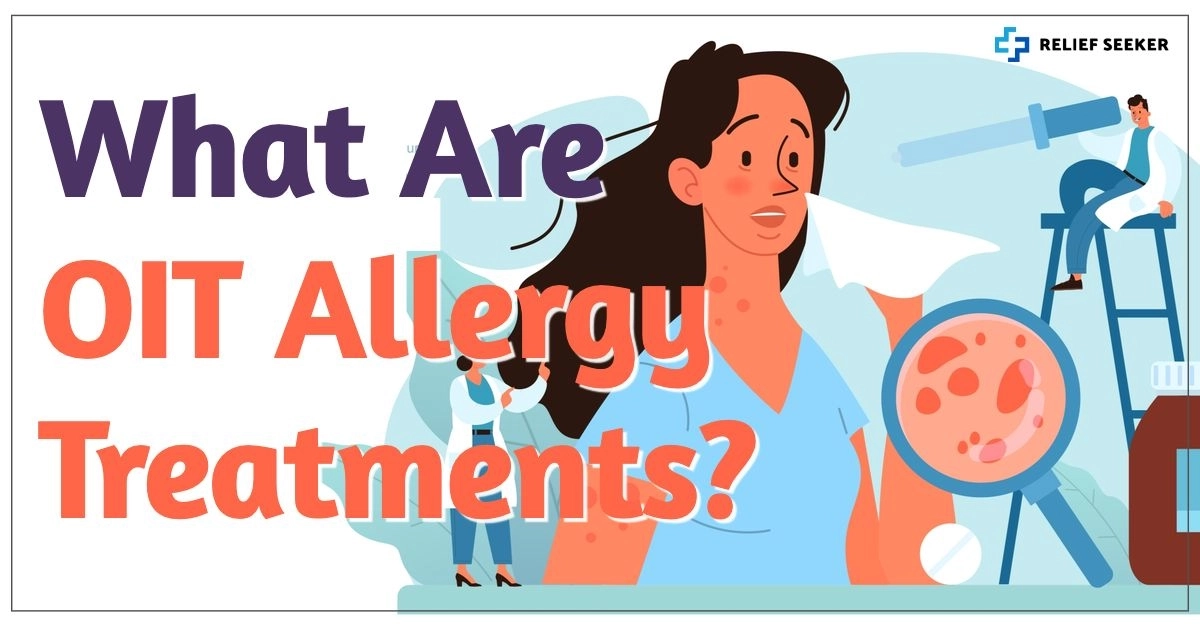Oral Immunotherapy (OIT) allergy treatments are a series of microdoses of allergens given to patients suffering from severe allergy symptoms.
These treatment options can increase an allergy sufferer’s quality of life and reduce symptoms. Gone are the days of relying solely on emergency treatment options (such as epinephrine) to manage food, environmental, seasonal, and animal allergy symptoms.
Discover how OIT allergy treatments can help you manage your severe allergy symptoms and get your allergies under control.
How Do OIT Allergy Treatments Work?
OIT allergy treatments are available for seasonal, environmental, animal, and peanut allergies (though, research has been completed on milk and egg allergies that may lead to FDA approval of future food allergy desensitization treatments).
Immunotherapy is simply introducing an allergen to the body, desensitizing the immune system to the allergen.
During an allergy attack, the immune system releases antibodies to ‘attack’ the allergen, believing it may harm the body. Instead, these antibodies cause inflammation, redness, hives, and other symptoms (even anaphylactic shock).
By introducing small amounts of these allergens to the system, the body may start to recognize them as non-threatening. The next time you have accidental exposure to allergens, your immune system shouldn’t overreact.
Allergies Treated by OIT Treatments
Oral immunotherapy Allergy treatments can help reduce allergy symptoms in food, seasonal, animal, and environmental allergies.
Oral immunotherapy refers to introducing small amounts of food allergens to a system to treat allergies, and allergy immunotherapy refers to introducing small amounts of allergens to the system via oral drops or shots for seasonal, animal, and environmental allergy relief.
Food Allergies
Most OIT allergy treatments target food allergies. Oral immunotherapy treatment specifically means that the immunotherapy treatment will be done orally (through small amounts of food allergens).
Food allergies affect more than 32 million Americans each year (including over five million children under the age of 18). The most common food allergies are dairy, nuts, shellfish, and seafood. Food allergies differ from food sensitivities in that allergies affect your system (specifically the respiratory system) as food enters your body — not as it moves through the digestive tract.
These allergies can be extremely dangerous, as the body may go into anaphylactic shock after consuming allergens.
Other symptoms of food allergies may include inflammation, dizziness, and shortness of breath.
The biggest difference between an OIT food allergy treatment and oral immunotherapy for other allergies is that your doctor will give you very small amounts of the food you’re allergic to in order to allow your body to build immunity (oral immunotherapy for seasonal, pet, and environmental allergies comes in droplet form).
Currently, peanut OIT is the only allergenic food immunotherapy available. If you’re allergic to food proteins in tree nuts or other foods, you’ll need to simply avoid those foods.
Seasonal Allergies
It’s also now possible to get oral allergy immunotherapy for seasonal allergies.
Seasonal allergies affect more than 50 million Americans each year, and these allergies are only getting worse. Global warming, climate change, and seasonal creep are to thank for shorter winters, early springs, late autumns, and warmer summers. If cold frosts can’t kill allergens over the winter, you may end up suffering for even longer each season.
Doctors treat seasonal allergies with oral immunotherapy drops. Simply place the daily dose of a few drops (just follow the instructions offered by your doctor) under your tongue each morning. The drops contain small amounts of allergens and will help your body build a resistance to such allergens.
Most patients in clinical trials see a reduction of symptoms of up to 40% within six months. You’ll also need to take several maintenance doses for up to five years.
Pet Allergies
If you’re allergic to animals, you may also be a good candidate for oral immunotherapy. The most common pet allergens include pet dander (dried dead skin cells), pet hair or fur, saliva, feces, and urine.
Immunotherapy is a great way to treat your pet allergies (without getting rid of your furry friends).
Environmental Allergies
Environmental allergies are similar to seasonal allergies. The biggest difference is that environmental allergies can happen any time, any place — not just during allergy seasons.
The most common environmental allergies include dust, dust mite, mold, and cockroaches.
While you may want to remove these allergens from your home anyway, getting oral immunotherapy to treat such allergies can ensure you don’t suffer from symptoms in areas that aren’t your home (such as outdoors, hotels, and workplaces).
OIT Treatments Vs Oral Allergy Treatments
The term OIT treatment is generally used when referring to treating food allergies with oral immunotherapy. Small amounts of food particles (specifically, peanuts) are generally given to patients in a controlled setting (such as a doctor’s office).
Oral allergy immunotherapy treatments are allergy immunotherapy drops that are taken as a tincture underneath the tongue; these drops aren’t used to treat food allergies, but they are used to treat environmental, pet, and seasonal allergies.
Both treatments are effective in preventing allergy attacks.
These treatments may not be right for you if you have a history of anaphylaxis or unmanageable asthma.
Types of OIT Allergy Treatments
There are currently three types of oral immunotherapy treatments: OIT allergy treatments for food allergies, allergy immunotherapy drops, and allergy toothpaste.
Oral Immunotherapy
OIT allergy treatments are specially designed for patients suffering from food allergies. Your immunologist or allergist will give you a very small microdose of the food you’re allergic to (under allergist supervision at a doctor’s office to prevent severe reactions).
Over time, your body should build up an immunity to these foods.
Allergy Immunotherapy Drops
Allergy immunotherapy drops are designed to help your body build up a resistance to seasonal, animal, and environmental allergens. You can buy these drops from an allergist, doctor, or online allergist.
Simply submit a recent allergy test and get drops that are specially designed to help your body build up a resistance to specific allergens. The first time you take the drops will either be at a doctor’s office or via a telehealth appointment to ensure you’re using the drops correctly (and that you don’t have an adverse reaction to the drops).
Allergy Toothpaste
Another newer immunotherapy treatment for allergies is allergy toothpaste. This prescription-only toothpaste contains trace amounts of allergens. Simply brush your teeth using this toothpaste as directed, and your body should start building up immunities to the allergens in the paste.
How to Get Oral Immunotherapy Treatments
Before getting oral immunotherapy, you’ll need to get tested for specific allergies. After you know what allergens cause your symptoms, you can get treated at an in-person doctor or through an online allergist.
Get Tested for Allergies
The first step in getting treated for allergies is to get tested for them! Before treating your symptoms, you’ll want to get tested for specific allergies for two reasons: your symptoms may not be caused by allergies at all, and you don’t want to treat allergies you don’t have.
Many patients self-diagnose their allergy symptoms and end up taking medications for the wrong reason. Many allergies share symptoms with other medical conditions, meaning your ‘allergy’ symptoms may not be caused by allergies at all.
Allergy testing is available through some primary care physicians, allergists, and telemedicine doctors. The most common tests are scratch tests and blood tests.
At-home testing kit companies such as EverlyWell sell allergy test kits that you can take right at home. Simply order your testing kit, follow the instructions to take a sample (usually via finger prick), and mail your sample to the lab. Results are usually available within a few days.
Head to a Doctor’s Office
Doctors and allergists generally administer OIT treatments (or at least supervise the first round of treatments). Simply call your doctor or get a referral to an allergist to get tested for specific allergies and begin the immunotherapy process.
Most doctors and allergists like to schedule at least one in-person appointment to explain how treatments work and to provide instruction on how to administer the treatments at home. In some cases, patients may experience an allergic reaction to oral therapy.
Doctors can provide immediate medical care for patients that experience these adverse reactions.
If you suffer from food allergies, you’ll need to head to a doctor’s office for oral immunotherapy. You’ll be given a small amount of a food allergen over time to allow your body to build up immunity to the allergen.
Contact a Telehealth Allergist
Seasonal allergy OIT treatments are now available through telehealth allergists, such as Curex. Telehealth allergist platforms often provide both allergy testing and treatment — from the comfort of your own home.
Simply fill out a form online to get started and take an at-home test kit. Your telehealth allergist will create an oral immunotherapy formula that’s personalized for your specific allergies. Your first few appointments are usually virtual (your allergist will explain how to use the drops via a video call and monitor your first dosage to ensure you don’t have any adverse reactions).
After, simply take your drops each day as directed. Most patients see 40% of symptoms clear up after six months, but it may take up to five years for symptoms to dissipate entirely.
Who Shouldn’t Get OIT Treatments
Some patients aren’t eligible for OIT treatments as they may have a higher risk of adverse side effects. The most common patients that shouldn’t be treated with OIT treatments are anyone that:
Has a higher risk of anaphylactic shock
Doesn’t have allergy symptoms under control
Suffers from a severe food allergy
OIT Allergy Treatment Alternatives
If you suffer from food allergies, the only treatment alternative to OIT is simply avoiding these foods altogether.
Yet, there are plenty of treatment alternatives to allergy immunotherapy for seasonal, animal, and environmental allergies, including personalized prescription allergy medication, over-the-counter (OTC) medication, and allergy shots.
Personalized Prescription Allergy Medication
Personalized prescription allergy medication can treat the symptoms of specific allergens, including pet dander, ragweed, pollen, mites, cockroaches, and more.
The most common types of personalized prescription medication are oral antihistamines, nasal sprays, and medicated eye drops. All three types of medications are available through most doctors and allergists.
The largest benefit of prescription medication is that you won’t end up taking too much or too little of an active ingredient. Your doctor or allergist can prescribe just the right amount of an active ingredient in your allergy medication to deal with your symptoms — without overmedicating.
Online allergist platforms like Picnic make getting an allergy prescription even easier. Simply create an account, fill out a form and get a consultation via email or message. All your allergy medications will be mailed to your address.
OTC Allergy Medication
Most prescription allergy medications are available in over-the-counter (OTC) doses as well. You can find these medications at most drugstores, pharmacies, big-box retailers (such as Target and Walmart), and online retailers.
The biggest downside to OTC allergy medications is that the dosage is one-size-fits-all. You won’t get a personalized amount of medication, and you may end up with too much or too little of the active ingredients.
Allergy Shots
Allergy shots are immunotherapy treatments, similar to oral immunotherapy. They work the same as oral immunotherapy (the biggest difference is that you’ll need to head to your doctor’s office to get the shots every few months instead of taking a few drops of oral immunotherapy each morning).


